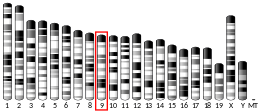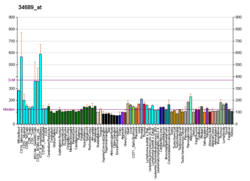TREX1
Three prime repair exonuclease 1 is an enzyme that in humans is encoded by the TREX1 gene.[5][6][7][8]
Function
This gene encodes the major 3'->5' DNA exonuclease in human cells. The protein is a non-processive exonuclease that may serve a proofreading function for a human DNA polymerase. It is also a component of the SET complex, and acts to rapidly degrade 3' ends of nicked DNA during granzyme A-mediated cell death. Mutations in this gene result in Aicardi-Goutieres syndrome, chilblain lupus, RVCL (Retinal Vasculopathy with Cerebral Leukodystrophy), and Cree encephalitis. Multiple transcript variants encoding different isoforms have been found for this gene.[8]
Clinical relevance
TREX1 helps HIV‑1 to evade cytosolic sensing by degrading viral cDNA in the cytoplasm[9]
References
- GRCh38: Ensembl release 89: ENSG00000213689 - Ensembl, May 2017
- GRCm38: Ensembl release 89: ENSMUSG00000049734 - Ensembl, May 2017
- "Human PubMed Reference:". National Center for Biotechnology Information, U.S. National Library of Medicine.
- "Mouse PubMed Reference:". National Center for Biotechnology Information, U.S. National Library of Medicine.
- Mazur DJ, Perrino FW (Aug 1999). "Identification and expression of the TREX1 and TREX2 cDNA sequences encoding mammalian 3'-->5' exonucleases". J Biol Chem. 274 (28): 19655–60. doi:10.1074/jbc.274.28.19655. PMID 10391904.
- Hoss M, Robins P, Naven TJ, Pappin DJ, Sgouros J, Lindahl T (Aug 1999). "A human DNA editing enzyme homologous to the Escherichia coli DnaQ/MutD protein". EMBO J. 18 (13): 3868–75. doi:10.1093/emboj/18.13.3868. PMC 1171463. PMID 10393201.
- Crow YJ, Hayward BE, Parmar R, Robins P, Leitch A, Ali M, Black DN, van Bokhoven H, Brunner HG, Hamel BC, Corry PC, Cowan FM, Frints SG, Klepper J, Livingston JH, Lynch SA, Massey RF, Meritet JF, Michaud JL, Ponsot G, Voit T, Lebon P, Bonthron DT, Jackson AP, Barnes DE, Lindahl T (Jul 2006). "Mutations in the gene encoding the 3'-5' DNA exonuclease TREX1 cause Aicardi-Goutieres syndrome at the AGS1 locus". Nat Genet. 38 (8): 917–20. doi:10.1038/ng1845. PMID 16845398.
- "Entrez Gene: TREX1 three prime repair exonuclease 1".
- Doyle, Thomas (27 April 2015). "HIV-1 and interferons: who's interfering with whom?". Nature Reviews Microbiology. 13 (Nature Reviews Microbiology 13): 403–413. doi:10.1038/nrmicro3449. PMID 25915633.
Further reading
- Tolmie JL, Shillito P, Hughes-Benzie R, Stephenson JB (1996). "The Aicardi-Goutières syndrome (familial, early onset encephalopathy with calcifications of the basal ganglia and chronic cerebrospinal fluid lymphocytosis)". J. Med. Genet. 32 (11): 881–4. doi:10.1136/jmg.32.11.881. PMC 1051740. PMID 8592332.
- Black DN, Watters GV, Andermann E, et al. (1989). "Encephalitis among Cree children in northern Quebec". Ann. Neurol. 24 (4): 483–9. doi:10.1002/ana.410240402. PMID 3239950.
- Perrino FW, Miller H, Ealey KA (1994). "Identification of a 3'-->5'-exonuclease that removes cytosine arabinoside monophosphate from 3' termini of DNA". J. Biol. Chem. 269 (23): 16357–63. PMID 8206943.
- Goutières F, Aicardi J, Barth PG, Lebon P (1999). "Aicardi-Goutières syndrome: an update and results of interferon-alpha studies". Ann. Neurol. 44 (6): 900–7. doi:10.1002/ana.410440608. PMID 9851434.
- Crow YJ, Jackson AP, Roberts E, et al. (2000). "Aicardi-Goutières Syndrome Displays Genetic Heterogeneity with One Locus (AGS1) on Chromosome 3p21". Am. J. Hum. Genet. 67 (1): 213–21. doi:10.1086/302955. PMC 1287108. PMID 10827106.
- Mazur DJ, Perrino FW (2001). "Structure and expression of the TREX1 and TREX2 3' --> 5' exonuclease genes". J. Biol. Chem. 276 (18): 14718–27. doi:10.1074/jbc.M010051200. PMID 11278605.
- Strausberg RL, Feingold EA, Grouse LH, et al. (2003). "Generation and initial analysis of more than 15,000 full-length human and mouse cDNA sequences". Proc. Natl. Acad. Sci. U.S.A. 99 (26): 16899–903. doi:10.1073/pnas.242603899. PMC 139241. PMID 12477932.
- Crow YJ, Black DN, Ali M, et al. (2003). "Cree encephalitis is allelic with Aicardi-Goutiéres syndrome: implications for the pathogenesis of disorders of interferon alpha metabolism". J. Med. Genet. 40 (3): 183–7. doi:10.1136/jmg.40.3.183. PMC 1735395. PMID 12624136.
- Ota T, Suzuki Y, Nishikawa T, et al. (2004). "Complete sequencing and characterization of 21,243 full-length human cDNAs". Nat. Genet. 36 (1): 40–5. doi:10.1038/ng1285. PMID 14702039.
- Gerhard DS, Wagner L, Feingold EA, et al. (2004). "The Status, Quality, and Expansion of the NIH Full-Length cDNA Project: The Mammalian Gene Collection (MGC)". Genome Res. 14 (10B): 2121–7. doi:10.1101/gr.2596504. PMC 528928. PMID 15489334.
- Unsal-Kaçmaz K, Mullen TE, Kaufmann WK, Sancar A (2005). "Coupling of Human Circadian and Cell Cycles by the Timeless Protein". Mol. Cell. Biol. 25 (8): 3109–16. doi:10.1128/MCB.25.8.3109-3116.2005. PMC 1069621. PMID 15798197.
- Rual JF, Venkatesan K, Hao T, et al. (2005). "Towards a proteome-scale map of the human protein-protein interaction network". Nature. 437 (7062): 1173–8. doi:10.1038/nature04209. PMID 16189514.
- Kimura K, Wakamatsu A, Suzuki Y, et al. (2006). "Diversification of transcriptional modulation: Large-scale identification and characterization of putative alternative promoters of human genes". Genome Res. 16 (1): 55–65. doi:10.1101/gr.4039406. PMC 1356129. PMID 16344560.
- Yoshioka K, Yoshioka Y, Hsieh P (2006). "ATR Kinase Activation Mediated by MutSα and MutLα in Response to Cytotoxic O6-Methylguanine Adducts". Mol. Cell. 22 (4): 501–10. doi:10.1016/j.molcel.2006.04.023. PMC 2423943. PMID 16713580.
- Chowdhury D, Beresford PJ, Zhu P, et al. (2006). "The exonuclease TREX1 is in the SET complex and acts in concert with NM23-H1 to degrade DNA during granzyme A-mediated cell death". Mol. Cell. 23 (1): 133–42. doi:10.1016/j.molcel.2006.06.005. PMID 16818237.
- Olsen JV, Blagoev B, Gnad F, et al. (2006). "Global, in vivo, and site-specific phosphorylation dynamics in signaling networks". Cell. 127 (3): 635–48. doi:10.1016/j.cell.2006.09.026. PMID 17081983.
External links
- GeneReviews/NCBI/NIH/UW entry on Aicardi-Goutières Syndrome
- OMIM entries on Aicardi-Goutieres syndrome





